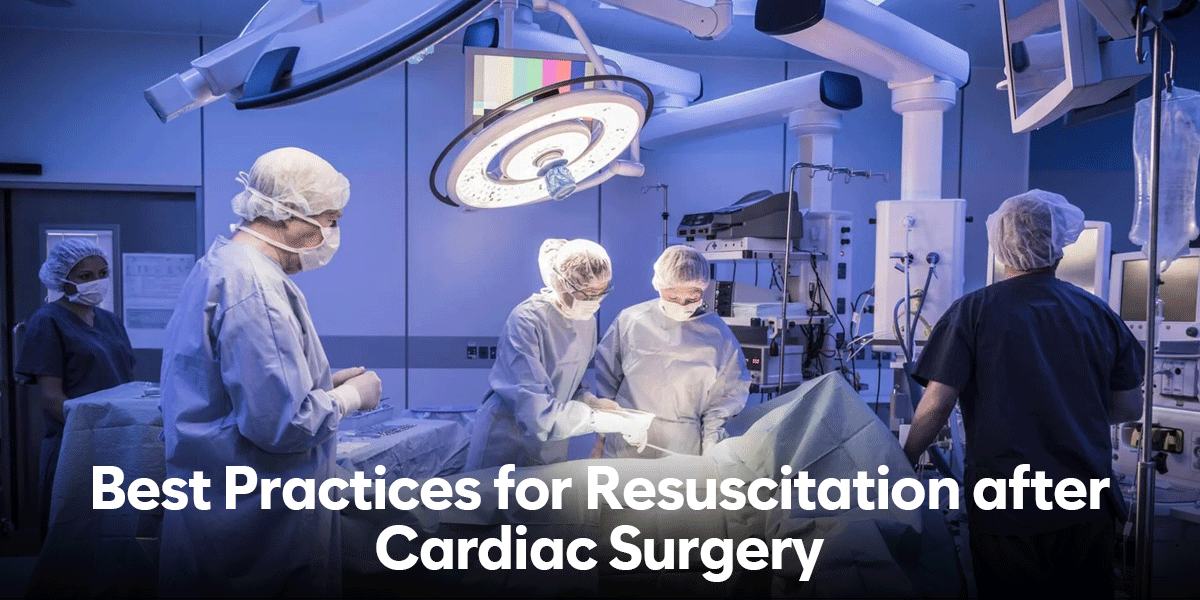Cardiac surgery, while life-saving, poses significant challenges for patients and healthcare providers alike. One of the critical phases following such procedures is resuscitation, where prompt and effective intervention can mean the difference between life and death.
In this blog, we delve into the best practices for resuscitation after cardiac surgery, highlighting key strategies and considerations that can optimize patient outcomes.
1. Preparedness and Team Coordination
The foundation of successful resuscitation lies in preparedness and seamless team coordination. Healthcare providers involved in post-cardiac surgery care must undergo regular training in advanced life support techniques. Thus, ensuring they are proficient in handling emergencies effectively. Establishing clear roles and responsibilities within the resuscitation team, along with effective communication protocols, is paramount for swift and coordinated action during critical moments.
2. Early Recognition of Deterioration
Vigilance is key in the postoperative period. As patients may be susceptible to sudden deterioration due to various factors such as bleeding, arrhythmias, or inadequate oxygenation. Nurses and other healthcare professionals should be trained to recognize subtle signs of deterioration promptly. This includes monitoring vital signs closely, assessing the patient’s level of consciousness, and staying attuned to any changes in clinical status.
3. Adequate Monitoring and Assessment
Continuous monitoring is essential for detecting early signs of hemodynamic instability or cardiac dysfunction. Utilization of advanced monitoring technologies such as invasive arterial pressure monitoring, central venous pressure monitoring, and cardiac output monitoring can provide valuable insights into the patient’s hemodynamic status. Additionally, regular assessment of fluid balance, electrolyte levels, and cardiac biomarkers can aid in identifying potential complications early on.
4. Optimization of Oxygenation and Ventilation
Maintaining adequate oxygenation and ventilation is crucial for postoperative patients, especially those undergoing cardiac surgery. Prompt initiation of supplemental oxygen therapy, optimization of ventilator settings, and early intervention in case of respiratory distress are vital components of effective resuscitation. Close attention should be paid to arterial blood gas analysis to ensure appropriate oxygenation and ventilation parameters are met.
5. Fluid Management and Hemodynamic Support
Fluid management plays a pivotal role in post-cardiac surgery resuscitation. While adequate fluid administration is essential to optimize cardiac output and tissue perfusion, excessive fluid administration can exacerbate myocardial edema and compromise respiratory function. Employing goal-directed fluid therapy guided by hemodynamic monitoring parameters can help strike a balance between fluid optimization and avoidance of fluid overload.
6. Pharmacological Interventions
Pharmacotherapy plays a significant role in managing postoperative complications and stabilizing hemodynamics. The judicious use of vasopressors, inotropes, and antiarrhythmic agents can help restore cardiovascular stability. Also, it helps mitigate the risk of adverse events. Healthcare providers must be knowledgeable about the pharmacokinetics and pharmacodynamics of these agents to tailor therapy according to individual patient needs.
7. Prompt Defibrillation and Cardiac Pacing
In the event of malignant arrhythmias such as ventricular fibrillation or pulseless ventricular tachycardia, prompt defibrillation is paramount. Automated external defibrillators (AEDs) should be readily accessible, and healthcare providers should be trained in their use to minimize the time to defibrillation. In cases of bradyarrhythmias or heart block, temporary cardiac pacing may be necessary to maintain adequate heart rate and cardiac output.
8. Multidisciplinary Collaboration and Continuity of Care
Resuscitation efforts after cardiac surgery require seamless collaboration among various healthcare disciplines. This includes cardiac surgeons, anesthesiologists, intensivists, nurses, and respiratory therapists. A multidisciplinary approach ensures comprehensive care and facilitates timely decision-making. Furthermore, continuity of care from the operating room to the intensive care unit and beyond is essential for optimizing patient outcomes and preventing complications.
9. Post-Resuscitation Care and Rehabilitation
Following successful resuscitation, attention should shift towards comprehensive post-resuscitation care and rehabilitation. This includes close monitoring for potential complications such as neurologic deficits, myocardial dysfunction, and systemic inflammatory response syndrome (SIRS). Early mobilization, physiotherapy, and cardiac rehabilitation programs play a crucial role in promoting recovery and restoring functional capacity.
10. Continuous Quality Improvement
Continuous quality improvement initiatives are essential for enhancing the effectiveness of resuscitation efforts and optimizing patient outcomes. Regular review of resuscitation data, analysis of adverse events, and implementation of evidence-based best practices are integral components of quality improvement programs. By identifying areas for improvement and implementing targeted interventions, healthcare institutions can continually elevate the standard of care in post-cardiac surgery resuscitation.
Conclusion
Effective resuscitation after cardiac surgery requires a multifaceted approach encompassing preparedness, early recognition, optimization of oxygenation and ventilation, fluid management, pharmacological interventions, prompt defibrillation, multidisciplinary collaboration, and continuous quality improvement. By adhering to these best practices and fostering a culture of excellence in postoperative care, healthcare providers can maximize patient survival and improve outcomes in this critical setting.





